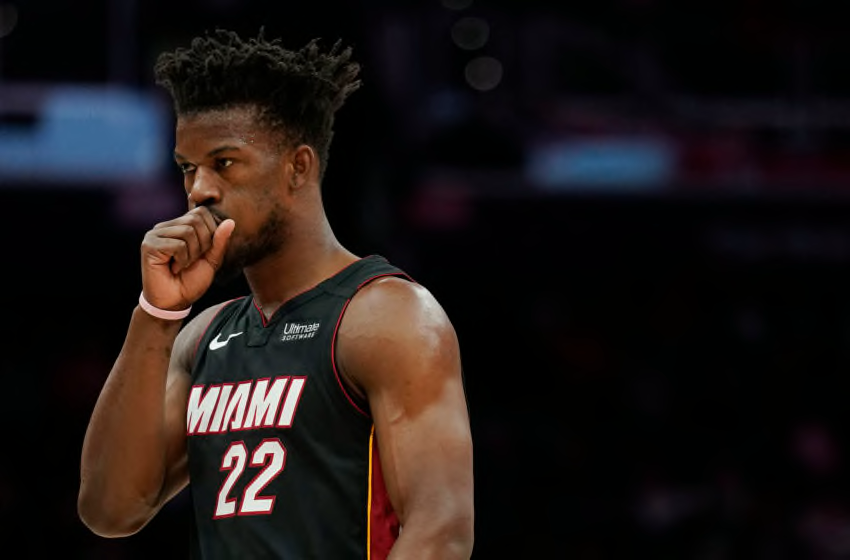
WASHINGTON, DC – MARCH 08: Jimmy Butler #22 of the Miami Heat looks on against the Washington Wizards in the first half at Capital One Arena on March 08, 2020 in Washington, DC. NOTE TO USER: User expressly acknowledges and agrees that, by downloading and or using this photograph, User is consenting to the terms and conditions of the Getty Images License Agreement. (Photo by Patrick McDermott/Getty Images)
The Miami Heat will make their playoff return in 2020 after adding Jimmy Butler in the offseason. What is the key to knocking them out?
The Miami Heat have impressed many fans in 2020, earning a 41-24 record prior to the NBA’s hiatus and clinching a playoff berth behind a deep stable of shooters and a perimeter-centric attack.
However, when looking deeper, there are evident cracks in the foundation. The Heat employ a very specific blueprint centered on volume from the 3-point line and play at a slow pace, forcing other teams to take advantage of limited opportunities and shoot from the perimeter.
For opposing teams, the blueprint to beating Miami is actually quite simple, and teams with the depth and defensive prowess to lock down the perimeter can shut down the Heat’s offense and ensure the team’s quick exit from the Orlando bubble. In order to do so, however, three focus points are key.
So, how do you beat the Miami Heat in a playoff series?
Chase the Heat off the 3-point line: The Heat live and die by the long ball, so it’s not surprise to see this as the top item on the list. Miami ranks among the top teams in the league in 3-point percentage and does not hesitate to pull the trigger from behind the arc.
Duncan Robinson, Tyler Herro, Meyers Leonard, and Kendrick Nunn all shoot well from behind the arc, and limiting their attempts (especially Robinson’s) is crucial for opposing teams. Defenses should focus on locking down the perimeter first and foremost because giving Miami’s shooters open catch-and-shoot looks is a recipe for disaster.
Opposing wings cannot give Miami space behind the arc, because the Heat will make them pay. Instead, defenses would give wise to chase the Heat off the line and force them to take mid-range looks.
Miami shoots just 36.6 percent from mid-range, a bottom-five mark in the league, compared to 38.3 percent from 3-point range. Contesting every 3-point attempt and keeping a presence in the paint could force the Heat out of their comfort zone, and teams will be glad to give up mid-range jumpers against a team that hates to shoot them.
Of course, doing this is easier said than done, especially for many defenses. However, a 3-2 zone could be the perfect sporadic counter to Miami’s offense, as dedicating more defenders to the 3-point line will discourage the Heat from taking their usual attempts from behind the arc.
Attack the paint on offense: While Miami’s style may encourage other teams to take more three-point attempts to keep pace on the scoreboard, attacking the Heat’s weak interior defense is ultimately a better strategy.
In the one of the team’s worst defensive performances of the year, a 124-121 loss to the Knicks, Miami had no answer for New York’s low-post offense. The Knicks scored 72 points in the paint and, despite trailing by as many as 14 points, won the game.
Although the Knicks are not a model of innovation, their strategy is just one instance of a larger trend. Miami allows the fifth-highest field goal percentage within five feet of the basket in the NBA, and teams who have chosen to attack this weakness have found success.
Without a dominant post presence on defense, elite post players who constantly attack the rim like Giannis Antetokounmpo and Joel Embiid, can exploit Meyers Leonard down low, ensuring an efficient shooting performance.
Most of the other Eastern Conference playoff teams, including Milwaukee, Toronto, Indiana, and Philadelphia, have talented post presences, a major cause for concern for Miami. If the Heat hope to make a deep playoff run, they will likely have to beat more than one of those teams in a seven-game series, but that is not likely without shoring up the team’s interior defense.
Speed up the pace: Miami likes to play at one of the league’s slowest paces, thriving off of ball movement and catch-and-shoot jumpers. While its easy for the Heat to control the pace of a game when they use up the shot clock, opposing teams can force them out of their comfort zone if they get out to an early lead.
Forcing Miami into an early hole is the easiest way to dismantle its play style. A potential second-round matchup like the Bucks, who play at the league’s highest pace, could give the Heat fits if they gain the advantage early. Miami has a concerning trend of coughing up leads, another sign that the team would struggle to rally from a sizable deficit.
The best way for teams to exploit this weakness is to generate turnovers and run in transition. Quick scoring runs will get the Heat out of their traditional offensive structure, forcing more pull-ups, isos, and contested shots early in the shot clock.
Obviously, gaining an early lead carries some degree of randomness, but strong transition teams with stingy half-court defenses could frustrate ball distributors like Jimmy Butler and Bam Adebayo, two crucial pieces in Miami’s attack.
While the other factors listed are certainly important, speeding up the pace of the game likely lends itself to good post play and perimeter defense. Getting shots near the rim comes easily when running in transition, and forcing the Heat out of their offensive structure will result in more contested looks from the perimeter.